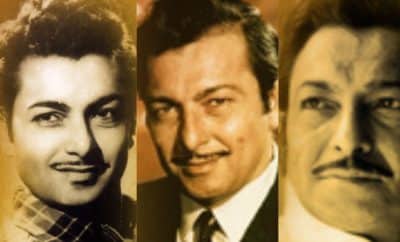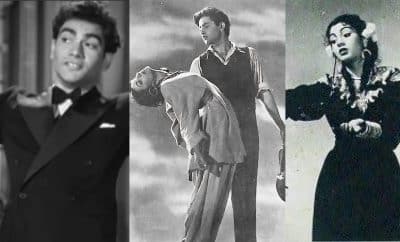Song Sketch
Hain Sabse Madhur Wo Geet – Patita – Melancholic Melodies are the Sweetest
Music is so innate to us humans! Be it a moment of extreme joy or a moment of extreme sorrow, expression is at its best when done through music. The songs of joy, no doubt, are melodious. But only melody doesn’t suffice when one is gung ho. Beats and dancing often accompany melody in merriment. But the songs of sorrow are often more melodious. When in grief, one tends to sing at a slow pace, and no frills are required. Melody therefore obviously takes the centre stage. That is why the sad songs often seem sweet. And that is why many of us prefer sad songs over the happy ones, irrespective of the mood. “Our sweetest songs are those that tell of saddest thought”, P.B.Shelley has also said. The eminent lyricist of the golden era, Kaviraj Shailendra, inspired by Shelley’s words, also coneys the same message through his song “Hain sabse madhur wo geet, jinhen hum dard ke sur mein gaate hain”, from Patita (1953).
Radha (Usha Kiran) is a poor young girl living in a shanty with her bedridden father. Unable to meet the ends, she is reduced to begging. One day, she bumps into the educated, suave, and kind-hearted Nirmal (Dev Anand) who severely criticises her for begging and directs her for a job to the factory that he himself owns; of course, without disclosing his identity as the factory owner. Eventually, Nirmal falls in love with the simple, pretty Radha and proposes to marry her. She readily and happily accepts the proposal.
However, soon in a cruel twist of fate, Radha visits her landlord for asking for some more time to clear the rent dues, where is raped by the landlord and conceives a child. She stops going to work and distances herself from Nirmal. Her father passes away due to this shock and helpless Radha attempts suicide. A poor but happy-go-lucky chap Mast Ram (Agha) dissuades her from suicide and offers her refuge in his own shanty. Radha delivers a baby in due course and decides to work to bring her baby up.
She goes to the same factory, this time to find out that Nirmal owns it. Agitated with her sudden absconding, Nirmal insults her and chases her away without giving her any job. He soon has a change of heart, finds out Radha’s whereabouts and gets to know that she has suffered a fate worse than death. He decides to marry her and hide the infant’s presence from him mother (Lalita Pawar) for the time being, to be disclosed at an opportune time. He puts Radha’s baby and Mast Ram up alongwith an ayah in a vacant mansion owned by his father.
Though life seems to be good to Radha for some time, it doesn’t seem to be in a mood to spare the poor lady. While Nirmal is away to manage a business disruption in another city, his mother comes to know about Radha’s baby and drives Radha away from the house. Having come to know about this, harrowed Nirmal starts returning home and meets with an accident on the way. On the very night, Nirmal’s spirit comes to meet Radha, who is bogged down with her unending problems and unaware of the mishap, is desperately waiting for him. The happy Radha rests her head in Nirmal’s lap. Gently caressing her, he tries to lift her spirits through the song in Talat Mahmood’s voice, Shailendra’s words, and Shankar – Jaikishan’s tune –
Hain sabse madhur wo geet, jinhen hum dard ke sur mein gaate hain
Jab had se guzar jaati hai khushi, aansoo bhi chhalakte aate hain…
Sweetest are the songs that we sing in sorrow. Sad songs are sweet because they come into being from our sufferings and pains like a ripe fruit. Our eyes are filled with tears not only when we are grieving, but also when there is excessive joy.
Nirmal continues singing after a brief interlude mainly comprising violins –
Kaanto mein khile hain phool hamaare rang bhare armaanon ke,
Naadaan hain jo in kaanton se daaman ko bachaaye jaate hain…
The colourful roses of our varicoloured wishes have bloomed amidst thorns. Silly are the ones who are afraid of the thorns, they would never get the roses. For there is no rose without a thorn!
Clouds suddenly cover the moon, and the night becomes darker. Nirmal continues to appease Radha –
Jab gham ka andhera ghir aaye, samjho ke sawera door nahin,
Har raat ka hai paigham yahi, taaren bhi yahi dohraaten hain…
When the darkness of sorrows amasses around you, rest assure that the dawn of happiness is not very far. Haven’t you learnt this from every night that passes by and gives rise to a new morning? Even the twinkling stars keep on telling us this every night.
The clouds scatter at once, and Nirmal’s face is illuminated by the moonlight. Nirmal says with utmost poise and optimism –
Pehlu mein paraaye dard basa ke hansna hansaana seekh zara,
Toofaan se keh de, ghir ke uthe, hum pyaar ke deep jalaate hain…
You are not the only person to face difficulties and sorrows. Almost everyone around us is fighting some battle. Don’t lose the sight of this fact of life and try to laugh and make others laugh. What’s the harm in spreading some joy if it makes all of us happy? Let the storm test our perseverance, we should not stop lighting the lamps of love!
Though Usha Kiran doesn’t have much scope for acting here, she perfectly represents a helpless woman beaten by the circumstances through her body language and subtle gestures. Though she has a passive role in the song, there is amazing consistency in her expressions throughout the song. Dev Anand’s facial expressions effortlessly show it all – immense love and compassion for Radha, maturity, positivity and aplomb.
Would there be a better choice of singer than Talat Mahmood for a song to appease someone? He does through his feather-soft rendition what Dev Anand does with his affectionate hand – caressing the desolate Radha.
Shankar – Jaikishan, who had arrived on the scene of Hindi film music with a bang just a few years before and had set new trends with long preludes and interludes and colossal orchestration, have underplayed in this song with limited musical instruments and short prelude and interludes to do complete justice to the situation. Their tune oozes love and compassion. They demonstrate their astounding proficiency in composing soulful and soothing songs as well.
Last but not the list – Kaviraj Shailendra! He has written beautiful lyrics in his signature style marked by simplicity and sincerity of expression. Without any difficult words or extravagant similes and metaphors, he expresses motivation and optimism, and easily conveys a philosophy. After the refrain and the first two stanzas which play at a personal level, he suddenly lifts the song to a universal level in the third stanza. There, the song connects personal sorrows with the universal ones, and indirectly states that grief is the only constant factor in life. Why not then look beyond our own sorrows and try to spread happiness? Life will always be testing, but this should not deter us from spreading love. This is where Shailendra always stands out from the other poets writing sentimental poems. His song talking about sadness doesn’t thus remain sad, it rather becomes heartening. He has stuck to his style of making nature a companion of human emotions by using the imagery such as roses and thorns, night and dawn, and storm.
You are still humming the refrain, aren’t you? You have also surely started firmly believing now that melancholic melodies are the sweetest. Such is the magic of the golden era music!




Vijay RAMAKANT Kulkarni
May 1, 2023 at 4:58 am
Beautifully written